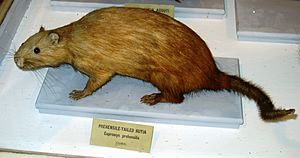Prehensile-tailed hutia facts for kids
Quick facts for kids Prehensile-tailed hutia |
|
|---|---|
 |
|
| Conservation status | |
| Scientific classification | |
| Genus: |
Mysateles
|
| Species: |
prehensilis
|
| Subspecies | |
|
M. p. gundlachi (Chapman, 1901) |
|
The prehensile-tailed hutia (Mysateles prehensilis) is a small, furry animal that looks a bit like a rat. It lives only in the forests of Cuba. This hutia spends its life climbing and living in trees. It eats only leaves. Sadly, its home is shrinking, which puts it at risk.
The prehensile-tailed hutia belongs to a group of rodents called hutias. Most hutias live in the Caribbean islands. Many of them are now endangered or have already disappeared. The prehensile-tailed hutia has one known type, called a subspecies. It is named M. prehensilis gundlachi. People also call it Chapman's prehensile-tailed hutia or Gundlach's hutia.
About the Name
The scientific name for the prehensile-tailed hutia is Mysateles prehensilis. The first part, Mysateles, comes from two old Ancient Greek words. One word means "mouse" or "rat." The other means "incomplete" or "imperfect."
This hutia is the only species left in its group, called a genus. This genus is named Mysateles. Other hutia species, like Garrido's hutia and the black-tailed hutia, used to be in the Mysateles group. But scientists later found they belonged in different groups. This means M. prehensilis is now the only one in its genus.
There is also a subspecies called Mysateles prehensilis gundlachi. It is also known as Chapman's prehensile-tailed hutia. This subspecies was once thought to be its own species. Another type, the Isla De La Juventud tree hutia, was also thought to be a separate species. But studies showed they are all just different types of the prehensile-tailed hutia.
Where They Live and How We Protect Them
The prehensile-tailed hutia lives in both old and new forests. It is found in some places in Cuba. The IUCN Red List says this animal is "near threatened." This means it might become endangered soon.
Even though you can find many of them in some areas, their numbers are going down. The biggest threats to these hutias are deforestation and habitat fragmentation. Deforestation means forests are being cut down. Habitat fragmentation means their forest homes are being broken into smaller, separate pieces. This makes it harder for them to find food and safe places to live.
See also
 In Spanish: Jutía carabalí para niños
In Spanish: Jutía carabalí para niños


